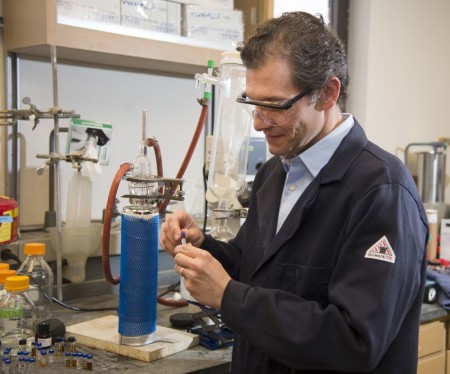Dec
18
A New Process to Make Use of Lignin
December 18, 2014 | 1 Comment
A new catalytic process from Purdue is able to convert the biomass waste lignin into lucrative chemical products that can be used to create high-octane fuel for racecars and jets or even in fragrances or flavorings. The Purdue team of researchers has developed a process that uses a chemical catalyst and heat to spur reactions that convert lignin into valuable chemical commodities.
Lignin is the notoriously tough and highly complex molecule that gives the plant cell wall its rigid structure. Plant biomass is made up primarily of lignin and cellulose, a long chain of sugar molecules that is the bulk material of plant cell walls. In standard production of ethanol, enzymes are used to break down the biomass and release sugars. Yeast then feast on the sugars and create ethanol. So far the lignin has defied economic use and clogged up the works.
Purdue University’s Center for Direct Catalytic Conversion of Biomass to Biofuels, or C3Bio professor Mahdi Abu-Omar, the R.B. Wetherill Professor of Chemistry and Professor of Chemical Engineering and associate director of C3Bio, led the team.

Mahdi Abu-Omar Purdue’s R.B. Wetherill Professor of Chemistry in His Lab. Professor Abu-Omar holds a small vial containing results of a new catalytic process that can convert the lignin in wood into high-value chemical products for use in fragrances and flavoring. Image Credit: Purdue University photo by Mark Simons. Click image for the largest view.
Professor Abu-Omar explained, “We are able to take lignin – which most biorefineries consider waste to be burned for its heat – and turn it into high-value molecules that have applications in fragrance, flavoring and high-octane jet fuels. We can do this while simultaneously producing from the biomass lignin-free cellulose, which is the basis of ethanol and other liquid fuels. We do all of this in a one-step process.”
Lignin acts as a physical barrier that makes it difficult to extract sugars from biomass and acts as a chemical barrier that poisons the enzymes. Many refining processes include harsh pretreatment steps to break down and remove lignin, he said.
“Lignin is far more than just a tough barrier preventing us from getting the good stuff out of biomass, and we need to look at the problem differently. While lignin accounts for approximately 25 percent of the biomass by weight, it accounts for approximately 37 percent of the carbon in biomass. As a carbon source lignin can be very valuable, we just need a way to tap into it without jeopardizing the sugars we need for biofuels,” professor Abu-Omar explained.
The Purdue team developed a process that starts with untreated chipped and milled wood from sustainable poplar, eucalyptus or birch trees. Abu-Omar described the process where a catalyst, a bimetallic Zn/Pd/C, is added to initiate and speed the desired chemical reactions, but is not consumed in the reactions and can be recycled and used again. A solvent is added to the mix to help dissolve and loosen up the materials. The mixture is contained in a pressurized reactor and heated for several hours. The process breaks up the lignin molecules and results in lignin-free cellulose and a liquid stream that contains two additional chemical products.
The liquid stream contains the solvent, which is easily evaporated and recycled, and two phenols, a class of aromatic hydrocarbon compounds used in perfumes and flavorings. A commonly used artificial vanilla flavoring is currently produced using a phenol that comes from petroleum.
The team also developed an additional process that uses another catalyst to convert the two phenol products into high-octane hydrocarbon fuel suitable for use as drop-in gasoline. The fuel produced has a research octane rating greater than 100, whereas the average gas we put into our cars has an octane rating in the eighties.
Professor Abu-Omar noted the catalyst is expensive, and the team plans to further study efficient ways to recycle it, along with ways to scale up the entire process.
Looking into the future the professor sees, “A biorefinery that focuses not only on ethanol, but on other products that can be made from the biomass (that) is more efficient and profitable overall. It is possible that lignin could turn out to be more valuable than cellulose and could subsidize the production of ethanol from sustainable biomass.”
The concept is already launching, the Purdue Research Foundation has filed patent applications and launched a startup company, Spero Energy, which was founded by Abu-Omar.
This work obviously has market legs. The abstract notes that the leftover carbohydrate residue when hydrolyzed by cellulases produces glucose at a 95% yield, which is comparable to a lignin-free cellulose. That seems like a miracle. The catalyst might well be expensive, but its likely worth it and will come down in cost as a market volume grows. It will be a kind of revolution to see lignin become a worthwhile commodity instead of a huge processing problem.
While professor Abu-Omar is the leader there is an impressive list of collaborators. Co-authors include Trenton Parsell, a visiting scholar in the Department of Chemistry; chemical engineering graduate students Sara Yohe, John Degenstein, Emre Gencer, and Harshavardhan Choudhari; chemistry graduate students Ian Klein, Tiffany Jarrell, and Matt Hurt; agricultural and biological engineering graduate student Barron Hewetson; Jeong Im Kim, associate research scientist in biochemistry; Basudeb Saha, associate research scientist in chemistry; Richard Meilan, professor of forestry and natural reserouces; Nathan Mosier, associate professor of agricultural and biological engineering; Fabio Ribeiro, the R. Norris and Eleanor Shreve Professor of Chemical Engineering; W. Nicholas Delgass, the Maxine S. Nichols Emeritus Professor of Chemical Engineering; Clint Chapple, the head and distinguished professor of biochemistry; Hilkka I. Kenttamaa, professor of chemistry; and Rakesh Agrawal, the Winthrop E. Stone Distinguished Professor of Chemical Engineering.
Comments
1 Comment so far


Could be huge.